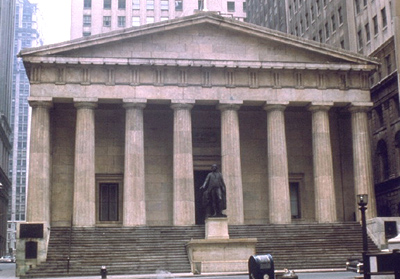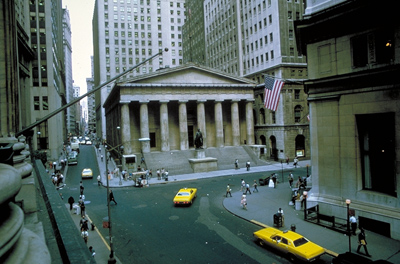
Historic Federal Hall continues to be key site
NEW YORK— The bustling, fast paced city of New York is home to several important landmarks and headquarters. However, many people do not know that it was the location for our nation’s first capitol.
Standing in lower Manhattan in the Wall Street Historic District is Federal Hall. Initially quarters for city hall, it was modified and remodeled by Frenchman Pierre L’Enfant in 1788 to become Federal Hall.
Surrounded by New York’s customary skyscrapers, the beautiful two-story Federal Hall National Memorial separates itself from other buildings in the surrounding area.
 |
Federal Hall, located in the heart of the Wall Street Historic District, features a statue of George Washington (Photo courtesy of the National Park Service). |
While large Doric columns proclaim the building’s significance. A bronze statue of George Washington greets people as they walk up the steps, and this structure proves itself to be a proper location for important happenings in the history of the United States.
Federal Hall hosted the first presidential inauguration, where George Washington accepted his role as president. In fact, the bible that Washington used on the day of inauguration still rests at the site on display.
Additionally, the earliest Congress came together at Federal Hall to develop the Bill of Rights.
However, this building has transformed functions numerous times. From Federal Hall, it became a U.S. Customs House in 1842. Twenty years later, it changed roles yet again to become the United States Sub-Treasury.
Now Federal Hall serves as a great informational resource for visitors of the New York area who are interested in history and significant national events. The building’s recent $16 million in renovations has aided its path to become a major tourist attraction.
Along the road to success, Federal Hall has seen disaster as well.
Being only two blocks away from the World Trade Center, on Sept. 11, 2001, the building suffered minor damage, as well as extreme smoke and dust conditions.
The building also revealed bravery from its National Park Service employees.
These employees provided shelter to more than150 civilians that day; supplying them with water, masks, cleaning supplies and a composed environment.
National Park Service employee Daniel Merced, helped guide people into Federal Hall for shelter. “I had about six people or so tugging and pulling on me. I had to be firm and tell them, “Relax, stay still, calm down.” People were screaming, “’I don’t want to die’” and “’I’m too young to die.’” I had no choice but to come right back to Federal Hall and drag these people with me,” said Merced.
Following the attack, on Sept. 6, 2002, Federal Hall revisited it’s role of national importance. The U.S. Senate and Congress assembled in New York for the first time in 212 years to discuss the plans for rebuilding the World Trade Center.
When original plans for the reconstruction were released, they were first displayed for the public in Federal Hall in an exhibit entitled, “Remember, Rebuild, Renew.”
Keeping up with its vital role as a National Memorial, on Dec. 14, 2006, Federal Hall was granted the right to display the original New York State Bill of Rights by the National Archives and Records Administration. This was the first public display of the Bill of Rights since it had been signed in 1790.
| Federal Hall seems hidden among the taller buildings of Lower Manhattan (Photo courtesy of the National Park Service). |  |
The National Archives and Records Administration is a federal agency that proclaims itself to “serving American democracy by safeguarding and preserving the records of U.S. government, and ensuring that the people can discover, use, and learn from this documentary heritage.”
A representative for the eight district of New York which covers the area of Federal Hall, Jerrold Nadler, stated that “Lower Manhattan, for the last century, has been known as a financial power center, but the district is also becoming a major cultural force as well.”
More recently, on March 5, Federal Hall’s district was listed on the State and National Registers of Historic Places.
In a recent press conference Carol Ash, a commissioner of the New York State Office of Parks, Recreation and Historic Preservation, described what it means to be on this register.
“This designation recognizes the area’s importance and will further its rejuvenation and redevelopment.” said Ash. The Wall Street Historic District continues to preserve its history and being on the register will allow it to mature as an historical site.
Federal Hall is now home to the Gateway to America: Discover New York Harbor Visitor Information Center. The center provides both ranger-guided and self-guided tours of the hall. It also provides information on 23 different destinations within the 10 national parks located in the New York Harbor area.
Federal hall is a continually growing, first-rate place to learn about our nation’s history. With unfixed exhibits, people are able to go periodically to see original works and new ideas.
If You Go
Federal Hall National Memorial
- 26 Wall St., New York, N.Y. 10005.
- 212-825-6888.
- http://www.nps.gov/feha
- Facilities: Visitor Center
- Directions: Public Transportation, Seventh Avenue #2 and #3 subway trains stop at Wall and William Streets, one block east of Federal Hall. Lexington Avenue #4 and #5 subway trains stop at Wall Street and Broadway, one block west of Federal Hall. J M and Z subway trains stop at Wall and Broad Streets Monday through Friday. Bus service is provided by route M-6 on Broadway, and by route M-15 on Water Street.
- Fees: None.
- Hours: Mondays through Fridays, 9 a.m. to 5 p.m.

Comments are Closed